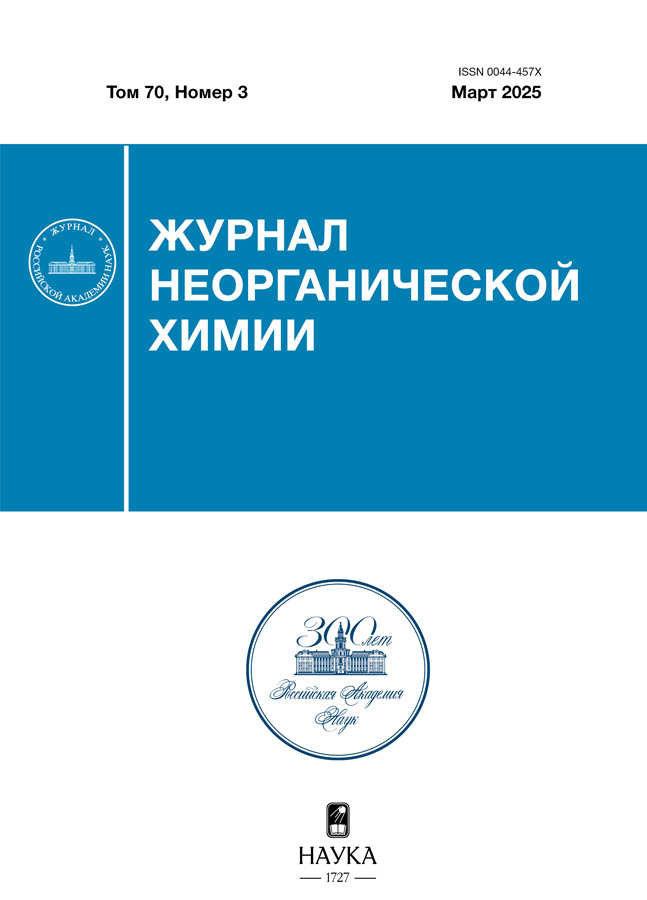Synthesis of micro- and mesoporous aluminosilicates in the presence of polyethylene glycol
- Авторлар: Arefieva O.D.1,2, Dovgan S.V.1, Kovekhova A.V.1,2, Panasenko A.E.2, Tsvetnov M.A.1, Kozlov A.G.1, Pervakov K.A.1
-
Мекемелер:
- Far Eastern Federal University
- Institute of Chemistry Far-Eastern Branch of the Russian Academy of Sciences
- Шығарылым: Том 70, № 3 (2025)
- Беттер: 315-326
- Бөлім: СИНТЕЗ И СВОЙСТВА НЕОРГАНИЧЕСКИХ СОЕДИНЕНИЙ
- URL: https://rjmseer.com/0044-457X/article/view/684980
- DOI: https://doi.org/10.31857/S0044457X25030037
- EDN: https://elibrary.ru/BCDYOW
- ID: 684980
Дәйексөз келтіру
Аннотация
Natural and synthetic aluminosilicates currently have a wide range of applications. Silicon-containing wastes of rice production are of great interest as a source of raw materials for their production. The purpose of this work is to synthesize micro- and mesoporous materials from rice husk by templat method using PEG-6000. The obtained samples were investigated by differential thermal analysis and IR spectroscopy, which showed the introduction of PEG into the structure of potassium aluminosilicate during sol-gel synthesis. The specific surface area of the samples and pore size distribution were determined by low-temperature nitrogen adsorption, according to which it was found that the pore radius increased from 100 to 200 Å during sol-gel synthesis when the PEG concentration was changed from 5 to 20 mmol/L. The study of the surface of the samples by scanning electron microscopy showed that the introduction of templat changes their surface morphology and promotes structuring.
Негізгі сөздер
Толық мәтін
Авторлар туралы
O. Arefieva
Far Eastern Federal University; Institute of Chemistry Far-Eastern Branch of the Russian Academy of Sciences
Email: dovgan.sv@dvfu.ru
Ресей, Vladivostok; Vladivostok
S. Dovgan
Far Eastern Federal University
Хат алмасуға жауапты Автор.
Email: dovgan.sv@dvfu.ru
Ресей, Vladivostok
A. Kovekhova
Far Eastern Federal University; Institute of Chemistry Far-Eastern Branch of the Russian Academy of Sciences
Email: dovgan.sv@dvfu.ru
Ресей, Vladivostok; Vladivostok
A. Panasenko
Institute of Chemistry Far-Eastern Branch of the Russian Academy of Sciences
Email: dovgan.sv@dvfu.ru
Ресей, Vladivostok
M. Tsvetnov
Far Eastern Federal University
Email: dovgan.sv@dvfu.ru
Ресей, Vladivostok
A. Kozlov
Far Eastern Federal University
Email: dovgan.sv@dvfu.ru
Ресей, Vladivostok
K. Pervakov
Far Eastern Federal University
Email: dovgan.sv@dvfu.ru
Ресей, Vladivostok
Әдебиет тізімі
- Hong-Tao L., Jiu-Jiang W., Fang-Ming X. et al. // Pet. Sci. 2023. V. 20. P. 1903. https://doi.org/10.1016/j.petsci.2022.11.028
- Nugrahaa R.E., Purnomo H., Aziz A. et al. // S. Afr. J. Chem. Eng. 2024. V. 49. P. 122. https://doi.org/10.1016/j.sajce.2024.04.009
- Yanga H., Han T., Yang W. et al. // J. Anal. Appl. Pyrolysis. 2022. V. 165. P. 105536. https://doi.org/10.1016/j.jaap.2022.105536
- Singh B.K., Bhadauria J., Tomar R. et al. // Desalination. 2022. V. 268. P. 189. https://doi.org/10.1016/j.desal.2010.10.022
- Singh B.K., Tomar R., Kumar S. et al. // J. Hazard. Mater. 2010. V. 178. P. 771. https://doi.org/10.1016/j.jhazmat.2010.02.007
- Bhadoria R., Singh B.K., Tomar R. // Desalination. 2010. V. 254. P. 192. https://doi.org/10.1016/j.desal.2009.11.016
- Mahinroosta M., Moattari R.M., Allahverdi A. et al. // Circ. Econ. 2024. P. 100100. https://doi.org/10.1016/j.cec.2024.100100
- Simancas R., Takemura M., Chen C.-T. // J. Non-Cryst. Solids. 2023. V. 605. P. 122172. https://doi.org/10.1016/j.jnoncrysol.2023.122172
- Шульц М.М. // Силикаты в природе и практике человека. 1997. С. 197.
- Sembiringa S., Simanjuntak W., Manurung P. et al. // Ceram. Int. 2014. V. 40. P. 7067. http://dx.doi.org/10.1016/j.ceramint.2013.12.038
- Darsanasiria A.G.N.D., Matalkahb F., Ramli S. et al. // J. Build. Eng. 2018. V. 19. P. 36. https://doi.org/10.1016/j.jobe.2018.04.020
- Simanjuntak W., Sembiring S., Manurung P. et al. // Ceram. Int. 2013. V. 39. P. 9369. http://dx.doi.org/10.1016/j.ceramint.2013.04.112
- Филиппова Е.О., Шафигулин Р.В., Виноградов К.Ю. и др. // Сорб. и хром. процессы. 2020. Т. 20. C. 696.
- Tretyakov Yu.D., Gudilin E.A. // Int. Sci. J. Alt. Energy Ecol. 2009. V. 6. № 74. C. 39.
- Глотов А.П., Ставицкая А.В., Новиков А.А. и др. // XI междунар. конф., посвященная 50-летию Института химии нефти СО РАН. Томск: Изд-во ИОА СО РАН. 2020. 65 с.
- Gautier C., Abdoul-Aribi N., Roux C. et al. // Colloids Surf. B: Biointerfaces. 2008. V. 65. № 1. P. 140. https://doi.org/10.1016/j.colsurfb.2008.03.005
- Shchipunov Y., Shipunova N. // Colloids Surf. B: Biointerfaces. 2008. V. 63. № 1. P. 7. http://doi.org/10.1016/j.colsurfb.2007.10.022
- Beck J.S., Vartuli J.C., Roth W.J. et al. // J. Am. Chem. Soc. 1992. V. 114. № 27. P. 10834. http://doi.org/10.1021/ja00053a020
- Casiraghi A., Selmin F., Minghetti P. et al. Nonionic Surfactants: Polyethylene Glycol (PEG) Ethers and Fatty Acid Esters as Penetration Enhancers. In: Dragicevic, N., Maibach, H. (eds) Percutaneous Penetration Enhancers Chemical Methods in Penetration Enhancement. Springer, Berlin, Heidelberg, 2015. https://doi.org/10.1007/978-3-662-47039-8_15
- Guo W., Luo G.S., Wang Y.J. et al. // J. Colloid Interface Sci. 2004. V. 207. № 2. P. 400. https://doi.org/10.1016/j.jcis.2003.08.056 - 20
- Яцковская О.В., Бакланова О.Н., Гуляева Т.И. и др. // Физикохимия поверхности и защита материалов. 2013. Т. 49. № 2. С. 223.
- Chen G., Jiang L., Wang L. et al. // Microporous Mesoporous Mater. 2010. V. 134. № 1-3. P. 189. http://doi.org/10.1016/j.micromeso.2010.05.025
- Xu F., Dong M., Gou W. et al. // Microporous Mesoporous Mater. 2012. V. 163. P. 192. http://doi.org/10.1016/j.micromeso.2012.07.030
- Li D., Zhu X. // ACS Mater. Lett. 2011. V. 11. P. 1528. http://doi.org/10.1016/j.matlet.2011.03.011
- Панасенко А.Е., Борисова П.Д., Арефьева О.Д. и др. // Химия растительного сырья. 2019. № 3. С. 291. http://doi.org/10.14258/jcprm.2019034278
- Иконникова К.В., Иконникова Л.Ф., Минакова Т.С. и др. Теория и практика рН-метрического определения кислотно-основных свойств поверхности твердых тел: учебное пособие. Томск: Изд-во Томского политехн. ун-та, 2011.
- Карнаухов А.П. Адсорбция. Текстура дисперсных и пористых материалов / Новосибирск: Издательство Сибирского отделения РАН, 1989.
- Грег С., Синг К. Адсорбция, удельная поверхность, пористость. Пер. с англ. / М.: Мир, 1984.
- Айлер Р.К. Химия кремнезема: растворимость, полимеризация, коллоидные и поверхностные свойства, биохимия. Пер. с англ. М.: Мир, 1982.
Қосымша файлдар

























